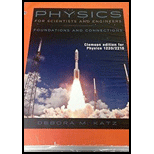
Concept explainers
(a)
The magnitude and direction of the electric field in the wire.
(a)
Answer to Problem 47PQ
The magnitude and direction of the electric field in the wire are
Explanation of Solution
Write the relation for the electric field in the wire.
Here,
Conclusion:
Substitute
Therefore, the magnitude and direction of the electric field in the wire are
(b)
The resistance of the wire.
(b)
Answer to Problem 47PQ
The resistance of the wire is
Explanation of Solution
Write the relation for the resistance of the cylindrical silver wire.
Here,
Conclusion:
Substitute
The resistance of the cylindrical silver wire is
(c)
The magnitude and direction of the current in the wire.
(c)
Answer to Problem 47PQ
The magnitude and direction of the current in the wire are
Explanation of Solution
Write the relation for the current in the cylindrical silver wire.
Here,
Conclusion:
Substitute
The current is in positive sign represents that it flows from left to right.
The magnitude and direction of the current in the wire are
(d)
The current density in the wire.
(d)
Answer to Problem 47PQ
The current density in the wire is
Explanation of Solution
Write the relation for the current density in the wire.
Here,
Conclusion:
Substitute
Therefore, the current density in the wire is
Want to see more full solutions like this?
Chapter 28 Solutions
Physics for Scientists and Engineers: Foundations and Connections
- An object is placed 24.1 cm to the left of a diverging lens (f = -6.51 cm). A concave mirror (f= 14.8 cm) is placed 30.2 cm to the right of the lens to form an image of the first image formed by the lens. Find the final image distance, measured relative to the mirror. (b) Is the final image real or virtual? (c) Is the final image upright or inverted with respect to the original object?arrow_forwardConcept Simulation 26.4 provides the option of exploring the ray diagram that applies to this problem. The distance between an object and its image formed by a diverging lens is 5.90 cm. The focal length of the lens is -2.60 cm. Find (a) the image distance and (b) the object distance.arrow_forwardPls help ASAParrow_forward
 Physics for Scientists and Engineers: Foundations...PhysicsISBN:9781133939146Author:Katz, Debora M.Publisher:Cengage Learning
Physics for Scientists and Engineers: Foundations...PhysicsISBN:9781133939146Author:Katz, Debora M.Publisher:Cengage Learning College PhysicsPhysicsISBN:9781938168000Author:Paul Peter Urone, Roger HinrichsPublisher:OpenStax College
College PhysicsPhysicsISBN:9781938168000Author:Paul Peter Urone, Roger HinrichsPublisher:OpenStax College College PhysicsPhysicsISBN:9781305952300Author:Raymond A. Serway, Chris VuillePublisher:Cengage Learning
College PhysicsPhysicsISBN:9781305952300Author:Raymond A. Serway, Chris VuillePublisher:Cengage Learning College PhysicsPhysicsISBN:9781285737027Author:Raymond A. Serway, Chris VuillePublisher:Cengage Learning
College PhysicsPhysicsISBN:9781285737027Author:Raymond A. Serway, Chris VuillePublisher:Cengage Learning Physics for Scientists and EngineersPhysicsISBN:9781337553278Author:Raymond A. Serway, John W. JewettPublisher:Cengage Learning
Physics for Scientists and EngineersPhysicsISBN:9781337553278Author:Raymond A. Serway, John W. JewettPublisher:Cengage Learning Physics for Scientists and Engineers with Modern ...PhysicsISBN:9781337553292Author:Raymond A. Serway, John W. JewettPublisher:Cengage Learning
Physics for Scientists and Engineers with Modern ...PhysicsISBN:9781337553292Author:Raymond A. Serway, John W. JewettPublisher:Cengage Learning





